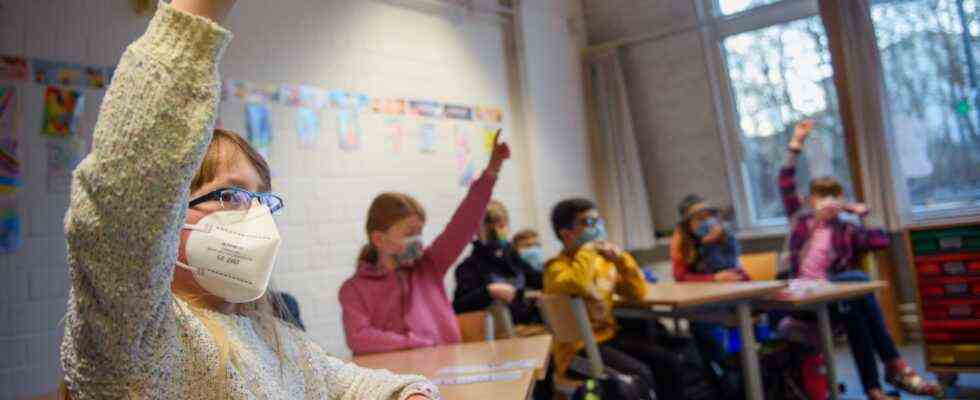fact finder
Status: 08/31/2021 11:20 a.m.
Many professionals and parents warn of “contamination” in children. The incidences in this age group are already extremely high in some cases. But how big is the risk of severe disease?
The Association of Education and Upbringing (VBE) warns of a corona “infection” in schools. “Instead of accepting or playing down infections, more protective measures must be taken when there are more infections among children and adolescents,” says VBE boss Udo Beckmann to the RND.
“We are running out of an infection among under twelve-year-olds because in many countries politics will or has already given up the incidence without providing adequate alternatives for under twelve-year-olds,” warns the virologist Martin Stürmer im ARD interview.
Difficult to compare
The President of the German Teachers’ Association, Heinz-Peter Meidinger, extrapolates figures from the USA on the hospitalization of children and adolescents: “If you transfer that to the number of students in Germany, about eleven million, that could mean up to 200,000 students in the worst case affect.”
However, figures from the USA cannot simply be transferred to Germany. Factors such as the vaccination rate, precautionary measures, the structure of the population and the quality of health care are among the factors that determine how many severe courses there are.
Experts warn against contamination of schools
Jan Zimmermann, DLF, August 27, 2021 11:01 am
Great Britain: no increasing number of severe courses
The comparison with the United Kingdom could be more revealing: On the one hand, the population structure is more comparable to the German, on the other hand, the country had to do with increasing numbers of infections from May onwards due to the delta variant and the relaxation of the measures. In July, the seven-day incidence there was just under 700 – almost 44 times as high as in Germany. Due to the vaccination rate, which is comparable to that in Germany, the number of patients who required intensive medical care remained relatively stable and, at almost 1000, did not even begin to reach the peak values (more than 4000) of the previous waves.
The number of severe courses in children is comparatively low, despite the very high incidences – and almost identical to the values of the previous waves of other variants: In calendar week 33, around 3.5 per 100,000 children under five were hospitalized because of Covid-19 treated.
Fourth wave affects the young and the unvaccinated
In Germany, the RKI refers to the request of the ARD fact finder on the risk of severe courses to the Standing Vaccination Commission, which stated: “Covid19 is generally not a serious illness in children and adolescents. The majority of SARS-CoV-2 infections are asymptomatic or with mild symptoms; deaths in children and adolescents without.” Previous illnesses are an absolute rarity. “
But if the number of infections increases sharply, even very rare cases can add up to a larger sum. And in some cities and regions, especially in NRW, the incidence in children is already extremely high – although autumn has not even begun. The RKI emphasized last week that the fourth wave mainly affects the unvaccinated and young people.
The number of hospitalizations is growing
Children are still very rarely affected by severe disease in relation to adults, but the number of hospitalizations is increasing. According to the RKI 54 infected children under ten years of age were hospitalized nationwide in calendar week 33. For comparison: In the same calendar week of the previous year there were eleven – even though there were still no vaccinations that could slow down the spread of the virus in adults and over twelve year olds and thus protect those who had not been vaccinated.
Dr. Robin Kobbe, specialist in pediatric and adolescent medicine, Infectious Diseases Section at the Eppendorf University Medical Center in Hamburg, emphasized at the request of the ARD fact finder, so far there are only a few studies on the special effects of the Delta variant in children and adolescents. But there is “no reason to assume that the significantly higher transferability is not also significant in younger age groups,” said Kobbe. Therefore, with increasing numbers of infections in children and adolescents, it can be assumed that “more children will also become so sick that they have to be treated in hospital”.
“Observe the regional situation closely”
Berit Lange from the Helmholtz Center for Infection Research said in an interview with the ARD fact finderThe implications of the Delta variant in terms of hospitalization for children have not yet been conclusively answered. Studies suggested that the risk of severe disease in all age groups was about 1.5 to two times higher than with previous variants. However, the uncertainties are particularly great with children because there are only a few cases, so it is unclear whether this also applies to children. It should be well understood that the delta variant is even more transferable compared to the alpha variant, which would be more relevant for the further course of the epidemic in the children.
Lange explains that very young children generally have to go to hospital more often after a SARS-CoV-2 infection than five to nine-year-olds. However, according to Lange, only a small proportion of children’s hospital admissions are very difficult or protracted. Nevertheless, the situation has to be monitored closely, especially regionally – as is now the case in North Rhine-Westphalia, because in addition to avoiding serious infections and complications in children, it is also about avoiding high burdens in the pediatric health care system.
Keep an eye on other viruses
The researcher emphasizes that not only Covid19 is relevant, but also other viruses that are now coming back and can cause severe respiratory diseases, especially in the youngest and an initial infection. Therefore, with a view to autumn, one should not only look at Covid19, but also, for example, at respiratory syncytial virus infections (RS viruses) and have to keep a close eye on the occupancy and capacity of the pediatric health system regionally and nationally.
Figures from Great Britain also show that RS viruses must be taken seriously there: in calendar week 33, more than 21 hospitalizations per 100,000 children were registered in connection with severe respiratory diseases caused by RS viruses. In the previous week, the value was even over 30 – and thus many times higher than Corona. For five to 14-year-olds, the ratio is reversed at a very low level: 1.26 per 100,000 children had to be treated as inpatients for Covid-19 – and 0.31 for RSV.
“Avoid Infections”
Helmholtz researcher Lange believes that it is a balancing act to keep daycare centers and schools open, but not simply to let the infections go through, because, for example, children with risk factors under the age of twelve have not yet been able to be vaccinated. This is another reason why it is still important to avoid infections. In general, the goal should be to avoid a high number of severe courses, complications and hospital admissions. And this number correlates with the number of cases.
UKE specialist Kobbe also believes that avoiding further infections “makes sense from an epidemiological and infectiological point of view and should continue to be pursued with the appropriate hygienic measures – especially in population groups that cannot be vaccinated”.
Pediatricians: no evidence of more severe courses
Burkhard Rodeck, Secretary General of the German Society for Child and Adolescent Medicine (DGKJ), said that ARD fact finder“neither according to the data of the German Society for Pediatric Infectious Diseases (DGPI), nor from the RKI data, a dramatic increase in inpatient treatments and thus indirectly in the serious course of the disease can be identified”. It is to be expected that the detected infections will increase due to the more contagious Delta variant, but the vast majority of these infections were mild or asymptomatic. In addition, there is a high rate of children who have already had an unnoticed Covid infection – and have thus acquired a certain immunity.
Rodeck also pointed out that other pathogens should not be neglected in the overall picture of respiratory diseases in children: In Germany, for example, many infections with RS viruses can be observed atypically for the time of year, so the DGPI / DGKJ has already issued a recommendation that children with corresponding risks vaccinate against these viruses with high priority.
Overall, there is an imbalance in the discussion in Germany with regard to the danger of Covid-19 for children: “Every serious infection of a child is of course very worrying for us and is dramatic for the children and their parents,” said Rodeck, “but dated In terms of the overall clinical picture, Covid-19 is not a particularly threatening infection for children, but rather comparable to flu and other respiratory diseases. According to the data from the DGPI register, ten children across Germany were diagnosed with Covid-19 in the last week Admitted to the hospital, many of them not because of COVID-19, but only with them. That is not a dramatic value. ”
Nonetheless, protection from infection remains important, and the Conference of Ministers of Education and Cultural Affairs in particular is “well advised” to implement “swiftly and consistently”, among other things, the guidelines drawn up by the DGKJ in schools.
Protection concepts as a solution?
Federal Minister of Health Jens Spahn said that ARD capital studio“This is precisely why test concepts, hygiene concepts and ventilation concepts are needed for daycare centers and schools”.
But it is precisely with these concepts and protective measures that there are again major differences between the federal states as well as massive failures. The quarantine rules vary significantly – and the purchase of air filters was dismissed as unnecessary for a long time because you could ventilate. Powers and responsibilities were shifted back and forth. In the meantime, the manufacturers of such devices can no longer meet the demand, so orders will sometimes still take many months.


